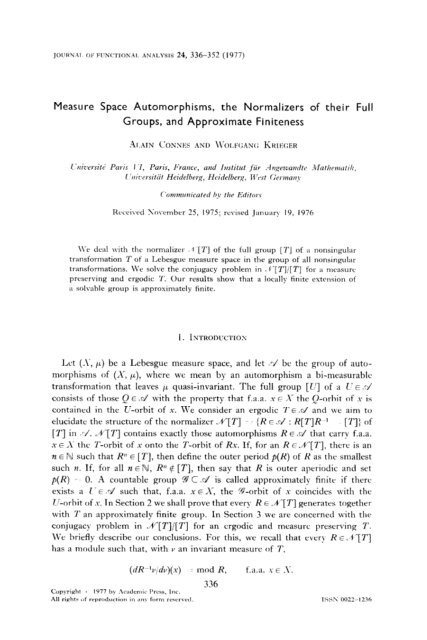Extension Theorems of Hahn-Banach Type for Nonlinear Disjointly ...
Extension Theorems of Hahn-Banach Type for Nonlinear Disjointly ...
Extension Theorems of Hahn-Banach Type for Nonlinear Disjointly ...
Create successful ePaper yourself
Turn your PDF publications into a flip-book with our unique Google optimized e-Paper software.
JOLTRWAI 01: FUNCTIOKAL ANALYSIS 24, 336-352 (I 977)<br />
Measure Space Automorphisms, the Normalizers <strong>of</strong> their Full<br />
Groups, and Approximate Finiteness<br />
\\‘e deal with the normalizer 2 ‘[T] <strong>of</strong> the full group [Tj <strong>of</strong> a nonsingular<br />
trans<strong>for</strong>mation ‘T <strong>of</strong> a Lebesgue measure space in the group <strong>of</strong> all nonsingular<br />
trans<strong>for</strong>mations. We solve the conjugacy problem in .1”[T]/[T] <strong>for</strong> a measure<br />
preserving and ergodic ‘1’. Our results show that a locally finite extension <strong>of</strong><br />
a solvable group is approximately finite.<br />
1. IXTRODLTTI~X<br />
Let (S, CL) be a Lebesgue measure space, and let .-1 be the group <strong>of</strong> auto-<br />
morphisms <strong>of</strong> (X, p), where we mean by an automorphism a bi-measurable<br />
trans<strong>for</strong>mation that leaves p quasi-invariant. The full group [C] <strong>of</strong> a I’ E .-/<br />
consists <strong>of</strong> those Q E .d with the property that f.a.a. ,Y F X- the Q-orbit <strong>of</strong> x is<br />
contained in the C-orbit <strong>of</strong> x. We consider an ergodic T E .rl’ and we aim to<br />
elucidate the structure <strong>of</strong> the normalizer .N[T] (R E .d : R[T]R .’ [T]j <strong>of</strong><br />
[T] in .c/. .k“[T] contains exactly those automorphisms R E J/ that cart-v f.a.a.<br />
x E A- the T-orbit <strong>of</strong> x onto the T-orbit <strong>of</strong> Rx. If, <strong>for</strong> an R E .N[T], there is an<br />
n E N such that R” E [T], then define the outer period p(H) <strong>of</strong> 12 as the smallest<br />
such II. If, <strong>for</strong> all n EN, R” r$ [T], then say that R is outer aperiodic and set<br />
p(R) 0. A countable group 9 C .d is called approximately finite if there<br />
exists a rV t .-/’ such that, f.a.a. x E X, the Y-orbit <strong>of</strong> s coincides with the<br />
U-orbit <strong>of</strong> s. In Section 2 we shall prove that every R t ./t’[T] generates together<br />
with T an approximately finite group. In Section 3 we are concerned with the<br />
conjugacy problem in .N[T]/[T] f or an crgodic and measure preserving T.<br />
We briefly describe our conclusions. For this, we recall that every R E N[T]<br />
has a module such that, with v an invariant measure <strong>of</strong> T,<br />
(c/R-‘v/ch~)(s) mod R, f.a.a. .x t .\-.<br />
ISSS 0022-1236

















